Our consultants assist students to focus on a specific gap in the knowledge and meet
the requirements in this chapter needed to defend the choice of that gap.
Chapter 1, with a highly focused review of the literature, and is normally the “prospectus” that a committee approves before the “proposal” to start research is approved. After the prospectus is approved, some of the review of literature may be moved into Chapter 2, which then becomes part of the proposal to do research.
Chapter 1 is the engine that drives the rest of the document, and it must be a complete empirical argument as is found in courts of law. It should be filled with proofs throughout. It is not a creative writing project in a creative writing class; hence, once a word or phrase is established in Chapter 1, use the same word or phrase throughout the dissertation. The content is normally stylized into five chapters, repetitive in some sections from dissertation to dissertation. A lengthy dissertation may have more than five chapters, but regardless, most universities limit the total number of pages to 350 due to microfilming and binding considerations in libraries in those institutions requiring hard copies.
Use plenty of transitional words and sentences from one section to another, as well as subheadings, which allow the reader to follow the writer’s train of thought. Following is an outline of the content of the empirical argument of Chapter 1. Universities often arrange the content in a different order, but the subject matter is the same in all dissertations because it is an empirical “opening statement” as might be found in a court of law. (Note that a dissertation could also be five pages of text and 50 pages of pictures of dragonfly wings and qualify for a Doctor’s degree in entomology.)
State the general field of interest in one or two paragraphs, and end with a sentence that states what study will accomplish. Do not keep the reader waiting to find out the precise subject of the dissertation.
Background of the Problem
This section is critically important as it must contain some mention of all the subject matter in the following Chapter 2 Review of the Literature 2 and the methodology in Chapter 3. Key words should abound that will subsequently be used again in Chapter 2. The section is a brief two to four page summary of the major findings in the field of interest that cites the most current finding in the subject area. A minimum of two to three citations to the literature per paragraph is advisable. The paragraphs must be a summary of unresolved issues, conflicting findings, social concerns, or educational, national, or international issues, and lead to the next section, the statement of the problem. The problem is the gap in the knowledge. The focus of the Background of the Problem is where a gap in the knowledge is found in the current body of empirical (research) literature.
Statement of the Problem
Arising from the background statement is this statement of the exact gap in the knowledge discussed in previous paragraphs that reviewed the most current literature found. A gap in the knowledge is the entire reason for the study, so state it specifically and exactly.
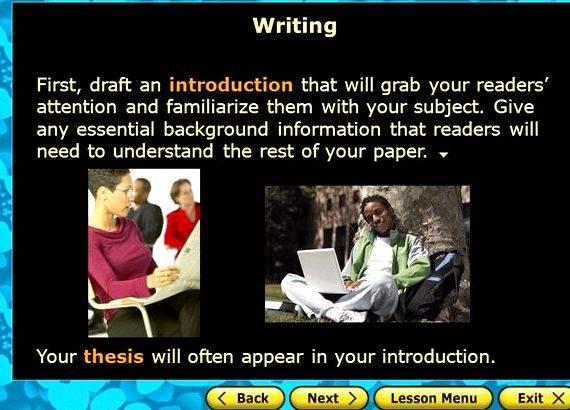
Use the words “gap in the knowledge.” The problem statement will contain a definition of the general need for the study, and the specific problem that will be addressed.
Purpose of the Study
The Purpose of the Study is a statement contained within one or two paragraphs that identifies the research design, such as qualitative, quantitative, mixed methods, ethnographic, or another design. The research variables, if a quantitative study, are identified, for instance, independent, dependent, comparisons, relationships, or other variables. The population that will be used is identified, whether it will be randomly or purposively chosen, and the location of the study is summarized. Most of these factors will be discussed in detail in Chapter 3.
Significance of the Study
The significance is a statement of why it is important to determine the answer to the gap in the knowledge, and is related to improving the human condition. The contribution to the body of knowledge is described, and summarizes who will be able to use the knowledge to make better decisions, improve policy, advance science, or other uses of the new information. The “new” data is the information used to fill the gap in the knowledge.
Primary Research Questions
The primary research question is the basis for data collection and arises from the Purpose of the Study. There may be one, or there may be several. When the research is finished, the contribution to the knowledge will be the answer to these questions. Do not confuse the primary research questions with interview questions in a qualitative study, or survey questions in a quantitative study. The research questions in a qualitative study are followed by both a null and an alternate hypothesis.
A hypothesis is a testable prediction for an observed phenomenon, namely, the gap in the knowledge. Each research question will have both a null and an alternative hypothesis in a quantitative study. Qualitative studies do not have hypotheses. The two hypotheses should follow the research question upon which they are based. Hypotheses are testable predictions to the gap in the knowledge. In a qualitative study the hypotheses are replaced with the primary research questions.
In Chapter 1 this is a summary of the methodology and contains a brief outline of three things: (a) the participants in a qualitative study or thesubjects of a quantitative study (human participants are referred tyo as participants, non-human subjects are referred to as subjects), (b) the instrumentation used to collect data, and (c) the procedure that will be followed. All of these elements will be reported in detail in Chapter 3. In a quantitative study, the instrumentation will be validated in Chapter 3 in detail. In a qualitative study, if it is a researcher-created questionnaire, validating the correctness of the interview protocol is usually accomplished with a pilot study. For either a quantitative or a qualitative study, using an already validated survey instrument is easier to defend and does not require a pilot study; however, Chapter 3 must contain a careful review of the instrument and how it was validated by the creator.
In a qualitative study, which usually involves interviews, the instrumentation is an interview protocol – a pre-determined set of questions that every participant is asked that are based on the primary research questions. A qualitative interview should contain no less than 10 open-ended questions and take no less than 1 hour to administer to qualify as “robust” research.
In the humanities, a demographic survey should be circulated with most quantitative and qualitative studies to establish the parameters of the participant pool. Demographic surveys are nearly identical in most dissertations. In the sciences, a demographic survey is rarely needed.
The theoretical framework is the foundational theory that is used to provide a perspective upon which the study is based. There are hundreds of theories in the literature. For instance, if a study in the social sciences is about stress that may be causing teachers to quit, Apple’s Intensification Theory could be cited as the theory was that stress is cumulative and the result of continuing overlapping, progressively stringent responsibilities for teachers that eventually leads to the desire to quit. In the sciences, research about new species that may have evolved from older, extinct species would be based on the theory of evolution pioneered by Darwin.
Some departments put the theoretical framework explanation in Chapter 1; some put it in Chapter 2.
Assumptions, Limitations, and Scope (Delimitations)
Assumptions are self-evident truths. In a qualitative study, it may be assumed that participants be highly qualified in the study is about administrators. It can be assumed that participants will answer truthfully and accurately to the interview questions based on their personal experience, and that participants will respond honestly and to the best of their individual abilities.
Limitations of a study are those things over which the research has no control. Evident limitations are potential weaknesses of a study. Researcher biases and perceptual misrepresentations are potential limitations in a qualitative study; in a quantitative study, a limitation may be the capability of an instrument to accurately record data.
Scope is the extent of the study and contains measurements. In a qualitative study this would include the number of participants, the geographical location, and other pertinent numerical data. In a quantitative study the size of the elements of the experiment are cited. The generalizability of the study may be cited. The word generalizability, which is not in the Word 2007 dictionary, means the extent to which the data are applicable in places other than where the study took place, or under what conditions the study took place.
Delimitations are limitations on the research design imposed deliberately by the researcher. Delimitations in a social sciences study would be such things as the specific school district where a study took place, or in a scientific study, the number of repetitions.
Definition of Terms
The definition of terms is written for knowledgeable peers, not people from other disciplines As such, it is not the place to fill pages with definitions that knowledgeable peers would know at a glance. Instead, define terms that may have more than one meaning among knowledgeable peers.
Summarize the content of Chapter 1 and preview of content of Chapter 2.
Source: Barbara von Diether, EdD
This section describes the main elements of a written thesis at the bachelor’s and master’s levels. Although the specific structure described here is most relevant for empirical theses, much of the advice is also relevant for theoretical work. Please note that the formal requirements vary between different disciplines, and make sure to confer the guidelines that apply in your field.
For the contents in the various sections you may also confer Organising your writing.
Abstract and foreword
Most readers will turn first to the abstract. Use it as an opportunity to spur the reader’s interest. The abstract should summarise the main contents of your thesis, especially the thesis statement, but does not need to cover every aspect of the main text. The main objective is to give the reader a good idea of what the thesis is about.
In general the abstract should be the last thing that you write, when you know what you have actually written. It is nevertheless a good idea to work on a draft continuously. Writing a good abstract is difficult, since it should only include the most important points of your work. But this is also why working on your abstract can be useful – it forces you to identify exactly what it is you are writing about.
There are usually no formal requirements for forewords, but it is common practice to thank your supervisors, informants, and others who have helped and supported you. If you have received any grants or research residencies, you should also acknowledge these.
Note: Shorter assignments do not require abstracts and forewords.
1. Introduction
Your introduction has two main purposes: 1) to give an overview of the main points of your thesis; and 2) awaken the reader’s interest. It’s not a bad idea to go through the introduction one last time when the writing is done, to ensure that it connects well with your conclusion.
Tip: For a nice, stylistic twist you can reuse a theme from the introduction in your conclusion. For example, you might present a particular scenario in one way in your introduction, and then return to it in your conclusion from a different – richer or contrasting – perspective.
Your introduction should include:
- The background for your choice of theme
- A discussion of your research question or thesis statement
- A schematic outline of the remainder of your thesis
The sections below discuss each of these elements in turn.
1.1 Background
The background sets the general tone for your thesis. It should make a good impression and convince the reader why the theme is important and your approach relevant. Even so, it should be no longer than necessary.
What is considered a relevant background depends on your field and its traditions. Background information might be historical in nature, or it might refer to previous research or practical considerations. You can also focus on a specific text, thinker or problem.
Academic writing often means having a discussion with yourself (or some imagined opponent). To open your discussion, there are several options available. You may, for example:
- refer to a contemporary event
- outline a specific problem; a case study or an example
- review the relevant research/literature to demonstrate the need for this particular type of research
If it is common in your discipline to reflect upon your experiences as a practitioner, this is the place to present them. In the remainder of your thesis, this kind of information should be avoided, particularly if it has not been collected systematically.
Tip: Do not spend too much time on your background and opening remarks before you have gotten started with the main text.
Exercise
Write three different opening paragraphs for your thesis using different literary devices
For example:
a) “set the scene” with a (short) narrative
b) adopt a historical approach to the phenomenon you intend to discuss
c) take an example from the media to give your topic current relevance.
Observe to what extent these different openings inspire you, and choose the approach most appropriate to your topic. For example, do you want to spur emotions, or remain as neutral as possible? How important is the historical background? The exercise can be done in small groups or pairs. Discuss what makes an opening paragraph successful (or not). How does your opening paragraph shed light on what is to follow? What will the reader’s expectations be?
1.2 Defining the scope of your thesis
One of the first tasks of a researcher is defining the scope of a study, i.e. its area (theme, field) and the amount of information to be included. Narrowing the scope of your thesis can be time-consuming. Paradoxically, the more you limit the scope, the more interesting it becomes. This is because a narrower scope lets you clarify the problem and study it at greater depth, whereas very broad research questions only allow a superficial treatment.
The research question can be formulated as one main question with (a few) more specific sub-questions or in the form of a hypothesis that will be tested.
Your research question will be your guide as your writing proceeds. If you are working independently, you are also free to modify it as you go along.
How do you know that you have drafted a research question? Most importantly, a research question is something that can be answered . If not, you have probably come up with a theme or field, not a question.
- Use interrogative words: how, why, which (factors/situations) etc.
- Some questions are closed and only invoke concrete/limited answers. Others will open up for discussions and different interpretations.
Asking “What &…?” is a more closed question than asking “How?” or “In what way?”
Asking “Why” means you are investigating what causes of a phenomenon. Studying causality is methodologically demanding. - Feel free to pose partially open questions that allow discussions of the overall theme, e.g. “In what way &…?”; “How can we understand [a particular phenomenon]?”
- Try to condense your research question into one general question – and perhaps a few more specific sub-questions (two or three will usually suffice).
1.3 Outline
The outline gives an overview of the main points of your thesis. It clarifies the structure of your thesis and helps you find the correct focus for your work. The outline can also be used in supervision sessions, especially in the beginning. You might find that you need to restructure your thesis. Working on your outline can then be a good way of making sense of the necessary changes. A good outline shows how the different parts relate to each other, and is a useful guide for the reader .
It often makes sense to put the outline at the end of the introduction, but this rule is not set in stone. Use discretion: What is most helpful for the reader? The information should come at the right point – not too early and not too late.
2. Theory section
The theory used in an empirical study is meant to shed light on the data in a scholarly or scientific manner. It should give insights not achievable by ordinary, everyday reflections. The main purpose of using theory is to analyse and interpret your data. Therefore, you should not present theoretical perspectives that are not being put to use. Doing so will create false expectations, and suggests that your work is incomplete.
Not all theses have a separate theory section. In the IMRaD format the theory section is included in the introduction, and the second chapter covers the methods used.
What kind of theory should you choose? Since the theory is the foundation for your data analysis it can be useful to select a theory that lets you distinguish between, and categorise different phenomena. Other theories let you develop the various nuances of a phenomenon. In other words, you have a choice of either reducing the complexity of your data or expanding upon something that initially looks simple.
How much time and space should you devote to the theory chapter? This is a difficult question. Some theses dwell too long on theory and never get to the main point: the analysis and discussion. But it is also important to have read enough theory to know what to look for when collecting data. The nature of your research should decide: Some studies do not require much theory, but put more emphasis on the method, while other studies need a rich theory section to enable an interesting discussion.
3. Method section
In a scholarly research article, the section dealing with method is very important. The same applies to an empirical thesis. For students, this can be a difficult section to write, especially since its purpose may not always be clear.
The method chapter should not iterate the contents of methodology handbooks. For example, if you have carried out interviews, you do not need to list all the different types of research interview. You also do not need to describe the differences between quantitative and qualitative methods, or list all different kinds of validity and reliability.
What you must do is to show how your choice of design and research method is suited to answering your research question(s). Demonstrate that you have given due consideration to the validity and reliability of your chosen method. By &”showing&” instead of &”telling&”, you demonstrate that you have understood the practical meaning of these concepts. This way, the method section is not only able to tie the different parts of your thesis together, it also becomes interesting to read!
- Show the reader what you have done in your study, and explain why. How did you collect the data? Which options became available through your chosen approach?
- What were your working conditions? What considerations did you have to balance?
- Tell the reader what you did to increase the validity of your research. E.g. what can you say about the reliability in data collection? How do you know that you have actually investigated what you intended to investigate? What conclusions can be drawn on this basis? Which conclusions are certain and which are more tentative? Can your results be applied in other areas? Can you generalise? If so, why? If not, why not?
- You should aim to describe weaknesses as well as strengths. An excellent thesis distinguishes itself by defending – and at the same time criticising – the choices made.
4. Analysis
Your analysis, along with your discussion, will form the high light of your thesis. In the IMRaD format, this section is titled “Results”. This is where you report your findings and present them in a systematic manner. The expectations of the reader have been built up through the other chapters, make sure you fulfill these expectations.
To analyse means to distinguish between different types of phenomena – similar from different. Importantly, by distinguishing between different phenomena, your theory is put to work. Precisely how your analysis should appear, however, is a methodological question. Finding out how best to organise and present your findings may take some time. A good place to look for examples and inspiration is repositories for master’s theses.
If you are analysing human actions, you may want to engage the reader’s emotions. In this case it will be important to choose analytical categories that correlate to your chosen theory. Engaging emotions is not the main point, but a way to elucidate the phenomenon so that the reader understands it in a new and better way.
Note. Not all theses include a separate chapter for analysis.
5. Discussion
In many thesis the discussion is the most important section. Make sure that you allocate enough time and space for a good discussion. This is your opportunity to show that you have understood the significance of your findings and that you are capable of applying theory in an independent manner.
The discussion will consist of argumentation. In other words, you investigate a phenomenon from several different perspectives. To discuss means to question your findings, and to consider different interpretations. Here are a few examples of formulations that signal argumentation:
- On the one hand &… and on the other
- But is it really true that&…
- &… on can it also be supposed&…?
- &… another possible explanation may be &…
6. Conclusion or summing up?
The final section of your thesis may take one of several different forms. Some theses need a conclusion, while for others a summing up will be appropriate. The decisive factor will be the nature of your thesis statement and research question.
Open research questions cannot always be answered, but if a definite answer is possible, you must provide a conclusion. The conclusion should answer your research question(s). Remember that a negative conclusion is also valid.
A summing up should repeat the most important issues raised in your thesis (particularly in the discussion), although preferably stated in a (slightly) different way. For example, you could frame the issues within a wider context.
Placing your thesis in perspective
In the final section you should place your work in a wider, academic perspective and determine any unresolved questions. During the work, you may have encountered new research questions and interesting literature which could have been followed up. At this point, you may point out these possible developments, while making it clear for the reader that they were beyond the framework of your current project.
- Briefly discuss your results through a different perspective. This will allow you to see aspects that were not apparent to you at the project preparation stage
- Highlight alternative research questions that you have found in the source materials used in the project
- Show how others have placed the subject area in a wider context
- If others have drawn different conclusions from yours, this will provide you with ideas of new ways to view the research question
- Describe any unanswered aspects of your project
- Specify potential follow up and new projects
A thesis should “bite itself in the tail”
There should be a strong connection between your conclusion and your introduction. All the themes and issues that you raised in your introduction must be referred to again in one way or another. If you find out at this stage that your thesis has not tackled an issue that you raised in the introduction, you should go back to the introduction and delete the reference to that issue. An elegant way to structure the text is to use the same textual figure or case in the beginning as well as in the end. When the figure returns in the final section, it will have taken on a new and richer meaning through the insights you have encountered, created in the process of writing.
J. Schimel, 2012 Writing Science. How to write papers that get cited and proposals that get funded. New York: Oxford University Press






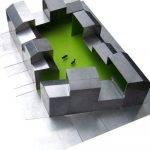 Social housing architecture thesis proposal
Social housing architecture thesis proposal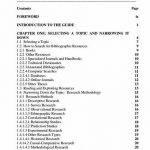 Writing a good masters thesis
Writing a good masters thesis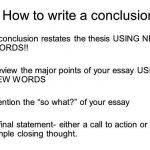 Writing a thesis flocabulary point
Writing a thesis flocabulary point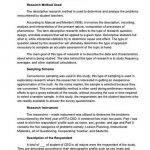 Data gathering instrument sample thesis proposal
Data gathering instrument sample thesis proposal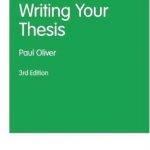 Writing your thesis sage publications careers
Writing your thesis sage publications careers






